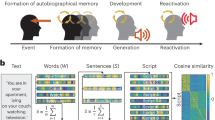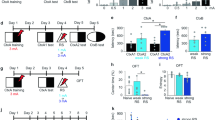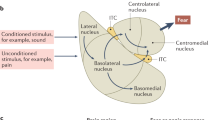Abstract
The neurocircuitry mechanisms underlying recall of traumatic memories remain unclear. This study investigated whether traumatic memory recall engages neurocircuitry representations that mirror activity patterns engaged during generalized threat stimulus processing in Post Traumatic Stress Disorder (PTSD). Multivariate pattern analysis was used to train 3 decoders. A “trauma” decoder was trained on fMRI patterns during idiographic trauma versus neutral narratives in a sample of 73 adult women with PTSD. A separate cohort of 125 adult participants completed a reward and threat learning task, from which “shock” and “reward loss” decoders were trained on neural patterns during threat or reward outcome delivery, respectively. These decoders were then cross-tested on the alternative datasets, allowing analyses of the degree to which traumatic memory recall engaged neurocircuitry representations that overlap with more general aversive stimuli. Decoders were trained and tested in four networks related to salience processing as well bilateral amygdala and hippocampal masks. The shock decoder trained in a midcingulate / posterior insula network demonstrated elevated predictions for shock during traumatic versus neutral memory recall. Similarly, the trauma decoder made elevated predictions about trauma recall during shock versus no shock delivery across multiple networks related to salience processing. There was no overlap between reward loss decoder predictions and trauma memory recall or vice versa. PTSD participants with elevated re-experiencing symptoms demonstrated the highest engagement of shock activity patterns during trauma memory recall. These results suggest that trauma memory recall engages neurocircuitry representations that overlap with threat, specifically painful, stimulus delivery.
This is a preview of subscription content, access via your institution
Access options
Subscribe to this journal
Receive 13 print issues and online access
$259.00 per year
only $19.92 per issue
Buy this article
- Purchase on SpringerLink
- Instant access to full article PDF
Prices may be subject to local taxes which are calculated during checkout





Similar content being viewed by others
Data availability
De-identified data have been deposited at Open Science Framework and are publicly available as of the date of publication. DOIs are listed in the key resources table. All original code has been deposited at Open Science Framework and is publicly available as of the date of publication. DOIs are listed in the key resources table. Any additional information required to reanalyze the data reported in this paper is available from the lead contact upon request.
References
Weathers FW, Bovin MJ, Lee DJ, Sloan DM, Schnurr PP, Kaloupek DG, et al. The Clinician-Administered PTSD Scale for DSM–5 (CAPS-5): Development and initial psychometric evaluation in military veterans. Psychol Assess. 2018;30:383.
Foa EB, Dancu CV, Hembree EA, Jaycox LH, Meadows EA, Street GP. A comparison of exposure therapy, stress inoculation training, and their combination for reducing posttraumatic stress disorder in female assault victims. J Consult Clin Psychol. 1999;67:194–200.
Foa EB, McLean CP, Capaldi S, Rosenfield D. Prolonged exposure vs supportive counseling for sexual abuse–related PTSD in adolescent girls: A randomized clinical trial. Jama. 2013;310:2650–7.
Monson CM, Schnurr PP, Resick PA, Friedman MJ, Young-Xu Y, Stevens SP. Cognitive processing therapy for veterans with military-related posttraumatic stress disorder. J Consult Clin Psychol. 2006;74:898–907.
Resick PA, Schnicke MK. Cognitive processing therapy for sexual assault victims. J Consult Clin Psychol. 1992;60:748–56.
Resick PA, Nishith P, Weaver TL, Astin MC, Feuer CA. A Comparison of Cognitive-Processing Therapy With Prolonged Exposure and a Waiting Condition for the Treatment of Chronic Posttraumatic Stress Disorder in Female Rape Victims. J Consult Clin Psychol. 2002;70:867–79.
Brewin CR, Holmes EA. Psychological theories of posttraumatic stress disorder. Clin Psychol Rev. 2003;23:339–76.
Brewin CR, Dalgleish T, Joseph S. A dual representation theory of posttraumatic stress disorder. Psychol Rev. 1996;103:670.
Foa EB, Hembree EA, Rothbaum BO. Prolonged exposure therapy for PTSD: emotional processing of traumatic experiences: therapist guide. New York: Oxford University Press; 2007.
Bedard-Gilligan M, Zoellner LA, Feeny NC. Is Trauma Memory Special? Trauma Narrative Fragmentation in PTSD: Effects of Treatment and Response. Clin Psychol Sci. 2017;5:212–25.
Brewin CR. Autobiographical memory for trauma: Update on four controversies. Memory. 2007;15:227–48.
Peace KA, Porter S, ten Brinke L. Are memories for sexually traumatic events “special”? A within-subjects investigation of trauma and memory in a clinical sample. Memory. 2008;16:10–21.
Engelhard IM, McNally RJ, van Schie K. Retrieving and Modifying Traumatic Memories: Recent Research Relevant to Three Controversies. Curr Dir Psychol Sci. 2019;28:91–96.
Perl O, Duek O, Kulkarni KR, Gordon C, Krystal JH, Levy I, et al. Neural patterns differentiate traumatic from sad autobiographical memories in PTSD. Nat Neurosci. 2023;26:2226–36.
Rothbaum BO, Davis M. Applying learning principles to the treatment of post-trauma reactions. Ann N. Y Acad Sci. 2003;1008:112–21.
Foa EB, Kozak MJ. Emotional processing of fear: Exposure to corrective information. Psychol Bull. 1986;99:20–35.
Craske MG, Kircanski K, Zelikowsky M, Mystkowski J, Chowdhury N, Baker A. Optimizing inhibitory learning during exposure therapy. Behav Res Ther. 2008;46:5–27.
Craske MG, Hermans D, Vervliet B. State-of-the-art and future directions for extinction as a translational model for fear and anxiety. Philos Trans R Soc B Biol Sci. 2018;373:20170025.
Dunsmoor JE, Cisler JM, Fonzo GA, Creech SK, Nemeroff CB. Laboratory models of post-traumatic stress disorder: The elusive bridge to translation. Neuron. 2022; 110:1754–76.
Dunsmoor JE, Niv Y, Daw N, Phelps EA. Rethinking extinction. Neuron. 2015;88:47–63.
Myers KM, Davis M. Mechanisms of fear extinction. Mol Psychiatry. 2007;12:120–50.
Foa EB, Rothbaum BO, Riggs DS, Murdock TB. Treatment of posttraumatic stress disorder in rape victims: a comparison between cognitive-behavioral procedures and counseling. J Consult Clin Psychol. 1991;59:715–23.
Pittig A, Heinig I, Goerigk S, Thiel F, Hummel K, Scholl L, et al. Efficacy of temporally intensified exposure for anxiety disorders: A multicenter randomized clinical trial. Depress Anxiety. 2021;38:1169–81.
Pittig A, Heinig I, Goerigk S, Richter J, Hollandt M, Lueken U, et al. Change of Threat Expectancy as Mechanism of Exposure-Based Psychotherapy for Anxiety Disorders: Evidence From 8,484 Exposure Exercises of 605 Patients. Clin Psychol Sci. 2023;11:199–217.
Craske MG, Treanor M, Conway C, Zbozinek T, Vervliet B. Maximizing Exposure Therapy: An Inhibitory Learning Approach. Behav Res Ther. 2014;58:10–23.
Ressler KJ, Rothbaum BO, Tannenbaum L, Anderson P, Graap K, Zimand E, et al. Cognitive enhancers as adjuncts to psychotherapy: use of D-cycloserine in phobic individuals to facilitate extinction of fear. Arch Gen Psychiatry. 2004;61:1136–44.
Ressler KJ, Berretta S, Bolshakov VY, Rosso IM, Meloni EG, Rauch SL, et al. Post-traumatic stress disorder: clinical and translational neuroscience from cells to circuits. Nat Rev Neurol. 2022;18:273–88.
Fenster RJ, Lebois LAM, Ressler KJ, Suh J. Brain circuit dysfunction in post-traumatic stress disorder: from mouse to man. Nat Rev Neurosci. 2018;19:535–51.
Cisler JM, Dunsmoor JE, Fonzo GA, Nemeroff CB. Latent-state and model-based learning in PTSD. Trends Neurosci. 2024;47:150–62.
Orr SP, Pitman RK, Lasko NB, Herz LR. Psychophysiological assessment of posttraumatic stress disorder imagery in World War II and Korean combat veterans. J Abnorm Psychol. 1993;102:152–9.
Pitman RK, Orr SP, Altman B, Longpre RE, Poiré RE, Macklin ML, et al. Emotional processing and outcome of imaginal flooding therapy in Vietnam veterans with chronic posttraumatic stress disorder. Compr Psychiatry. 1996;37:409–18.
Pitman RK, Orr SP, Forgue DF, de Jong JB, Claiborn JM. Psychophysiologic assessment of posttraumatic stress disorder imagery in Vietnam combat veterans. Arch Gen Psychiatry. 1987;44:970–5.
Pole N. The psychophysiology of posttraumatic stress disorder: a meta-analysis. Psychol Bull. 2007;133:725.
Sartory G, Cwik J, Knuppertz H, Schürholt B, Lebens M, Seitz RJ, et al. In search of the trauma memory: a meta-analysis of functional neuroimaging studies of symptom provocation in posttraumatic stress disorder (PTSD). PloS One. 2013;8:e58150.
Hopper JW, Frewen PA, van der Kolk BA, Lanius RA. Neural correlates of reexperiencing, avoidance, and dissociation in PTSD: Symptom dimensions and emotion dysregulation in responses to script-driven trauma imagery. J Trauma Stress. 2007;20:713–25.
Lanius RA, Williamson PC, Densmore M, Boksman K, Neufeld RW, Gati JS, et al. The Nature of Traumatic Memories: A 4-T fMRI Functional Connectivity Analysis. Am J Psychiatry. 2004;161:36–44.
Lanius RA, Williamson PC, Boksman K, Densmore M, Gupta M, Neufeld RW, et al. Brain activation during script-driven imagery induced dissociative responses in PTSD: a functional magnetic resonance imaging investigation. Biol Psychiatry. 2002;52:305–11.
Bremner JD, Narayan M, Staib LH, Southwick SM, McGlashan T, Charney DS. Neural Correlates of Memories of Childhood Sexual Abuse in Women With and Without Posttraumatic Stress Disorder. Am J Psychiatry. 1999;156:1787–95.
Shin LM, McNally RJ, Kosslyn SM, Thompson WL, Rauch SL, Alpert NM, et al. Regional Cerebral Blood Flow During Script-Driven Imagery in Childhood Sexual Abuse-Related PTSD: A PET Investigation. Am J Psychiatry. 1999;156:575–84.
Lanius RA, Williamson PC, Bluhm RL, Densmore M, Boksman K, Neufeld RW, et al. Functional connectivity of dissociative responses in posttraumatic stress disorder: a functional magnetic resonance imaging investigation. Biol Psychiatry. 2005;57:873–84.
Cisler JM, Steele JS, Lenow JK, Smitherman S, Everett B, Messias E, et al. Functional reorganization of neural networks during repeated exposure to the traumatic memory in posttraumatic stress disorder: an exploratory fMRI study. J Psychiatr Res. 2014;48:47–55.
Fullana MA, Albajes-Eizagirre A, Soriano-Mas C, Vervliet B, Cardoner N, Benet O, et al. Fear extinction in the human brain: A meta-analysis of fMRI studies in healthy participants. Neurosci Biobehav Rev. 2018;88:16–25.
Fullana MA, Harrison BJ, Soriano-Mas C, Vervliet B, Cardoner N, Àvila-Parcet A, et al. Neural signatures of human fear conditioning: an updated and extended meta-analysis of fMRI studies. Mol Psychiatry. 2016;21:500–8.
Pitman RK, Rasmusson AM, Koenen KC, Shin LM, Orr SP, Gilbertson MW, et al. Biological studies of post-traumatic stress disorder. Nat Rev Neurosci. 2012;13:769–87.
Patel R, Spreng RN, Shin LM, Girard TA. Neurocircuitry models of posttraumatic stress disorder and beyond: A meta-analysis of functional neuroimaging studies. Neurosci Biobehav Rev. 2012;36:2130–42.
Rauch SL, Shin LM, Phelps EA. Neurocircuitry Models of Posttraumatic Stress Disorder and Extinction: Human Neuroimaging Research—Past, Present, and Future. Biol Psychiatry. 2006;60:376–82.
Admon R, Milad MR, Hendler T. A causal model of post-traumatic stress disorder: disentangling predisposed from acquired neural abnormalities. Trends Cogn Sci. 2013;17:337–47.
Poldrack RA. The role of fMRI in Cognitive Neuroscience: where do we stand? Curr Opin Neurobiol. 2008;18:223–7.
Poldrack RA. Can cognitive processes be inferred from neuroimaging data? Trends Cogn Sci. 2006;10:59–63.
Moughrabi N, Botsford C, Gruichich TS, Azar A, Heilicher M, Hiser J, et al. Large-scale neural network computations and multivariate representations during approach-avoidance conflict decision-making. NeuroImage. 2022;264:119709.
Weaver SS, Kroska EB, Ross MC, Sartin-Tarm A, Sellnow KA, Schaumberg K, et al. Sacrificing reward to avoid threat: Characterizing PTSD in the context of a trauma-related approach–avoidance conflict task. J Abnorm Psychol. 2020;129:457.
Orr SP, Lasko NB, Metzger LJ, Berry NJ, Ahern CE, Pitman RK. Psychophysiologic assessment of women with posttraumatic stress disorder resulting from childhood sexual abuse. J Consult Clin Psychol. 1998;66:906–13.
Bayer JMM, Thompson PM, Ching CRK, Liu M, Chen A, Panzenhagen AC, et al. Site effects how-to and when: An overview of retrospective techniques to accommodate site effects in multi-site neuroimaging analyses. Front Neurol. 2022;13:1–24.
Fortin J-P, Cullen N, Sheline YI, Taylor WD, Aselcioglu I, Cook PA, et al. Harmonization of cortical thickness measurements across scanners and sites. NeuroImage. 2018;167:104–20.
Orlhac F, Eertink JJ, Cottereau A-S, Zijlstra JM, Thieblemont C, Meignan M, et al. A Guide to ComBat Harmonization of Imaging Biomarkers in Multicenter Studies. J Nucl Med. 2022;63:172–9.
Yu M, Linn KA, Cook PA, Phillips ML, McInnis M, Fava M, et al. Statistical harmonization corrects site effects in functional connectivity measurements from multi-site fMRI data. Hum Brain Mapp. 2018;39:4213–27.
Mumford JA, Turner BO, Ashby FG, Poldrack RA. Deconvolving BOLD activation in event-related designs for multivoxel pattern classification analyses. NeuroImage. 2012;59:2636–43.
Cisler JM, Dunsmoor JE, Privratsky AA, James GA. Decoding neural reactivation of threat during fear learning, extinction, and recall in a randomized clinical trial of L-DOPA among women with PTSD. Psychol Med. 2024;54:1091–101.
Cisler JM, Tamman AJF, Fonzo GA. Diminished prospective mental representations of reward mediate reward learning strategies among youth with internalizing symptoms. Psychol Med. 2023;53:6910–20.
Xu A, Larsen B, Baller EB, Scott JC, Sharma V, Adebimpe A, et al. Convergent neural representations of experimentally-induced acute pain in healthy volunteers: A large-scale fMRI meta-analysis. Neurosci Biobehav Rev. 2020;112:300–23.
Menon V. Large-scale brain networks and psychopathology: a unifying triple network model. Trends Cogn Sci. 2011;15:483–506.
Ghahremani A, Rastogi A, Lam S. The role of right anterior insula and salience processing in inhibitory control. J Neurosci. 2015;35:3291–2.
Čeko M, Kragel PA, Woo C-W, López-Solà M, Wager TD. Common and stimulus-type-specific brain representations of negative affect. Nat Neurosci. 2022;25:760–70.
Chang C-C, Lin C-J. LIBSVM: A Library for Support Vector Machines. ACM Trans Intell Syst Technol. 2011;2:27. 1-27:27
Zhou F, Zhao W, Qi Z, Geng Y, Yao S, Kendrick KM, et al. A distributed fMRI-based signature for the subjective experience of fear. Nat Commun. 2021;12:6643.
Vogt BA. Pain and emotion interactions in subregions of the cingulate gyrus. Nat Rev Neurosci. 2005;6:533–44.
Tan LL, Pelzer P, Heinl C, Tang W, Gangadharan V, Flor H, et al. A pathway from midcingulate cortex to posterior insula gates nociceptive hypersensitivity. Nat Neurosci. 2017;20:1591–601.
Uddin LQ. Salience processing and insular cortical function and dysfunction. Nat Rev Neurosci. 2015;16:55–61.
Funding
J.M.C. is supported by MH119132, MH108753, MH132784, MH132722, and AA030740. J.E.D. is supported by MH122387. ZNS is supported by MH119132, MH108753.
Author information
Authors and Affiliations
Contributions
Conceptualization, KRM, JED, JMC; Methodology, KRM, JED, JMC; Data Curation KRM, JMC, MJ, ZNS; Investigation, KRM, JED, ZNS, JMC; Writing – Original Draft, KRM, JMC; Writing – Reviewing & Editing, KRM, JED, ZNS, MJ, JMC; Resources JMC, JED, ZNS, Funding Acquisition, JMC, JED, ZNS, Supervision, JMC.
Corresponding author
Ethics declarations
Dr Stowe reported receiving consultant fees from the CDC during the conduct of the study and being on the advisory board of Reunion Neuroscience outside the submitted work. The other authors declare no competing interests.
Additional information
Publisher’s note Springer Nature remains neutral with regard to jurisdictional claims in published maps and institutional affiliations.
Supplementary information
Rights and permissions
Springer Nature or its licensor (e.g. a society or other partner) holds exclusive rights to this article under a publishing agreement with the author(s) or other rightsholder(s); author self-archiving of the accepted manuscript version of this article is solely governed by the terms of such publishing agreement and applicable law.
About this article
Cite this article
Morris, K.R., Jaeb, M., Dunsmoor, J.E. et al. Decoding threat neurocircuitry representations during traumatic memory recall in PTSD. Neuropsychopharmacol. 50, 568–575 (2025). https://doi.org/10.1038/s41386-024-02028-5
Received:
Revised:
Accepted:
Published:
Issue date:
DOI: https://doi.org/10.1038/s41386-024-02028-5



